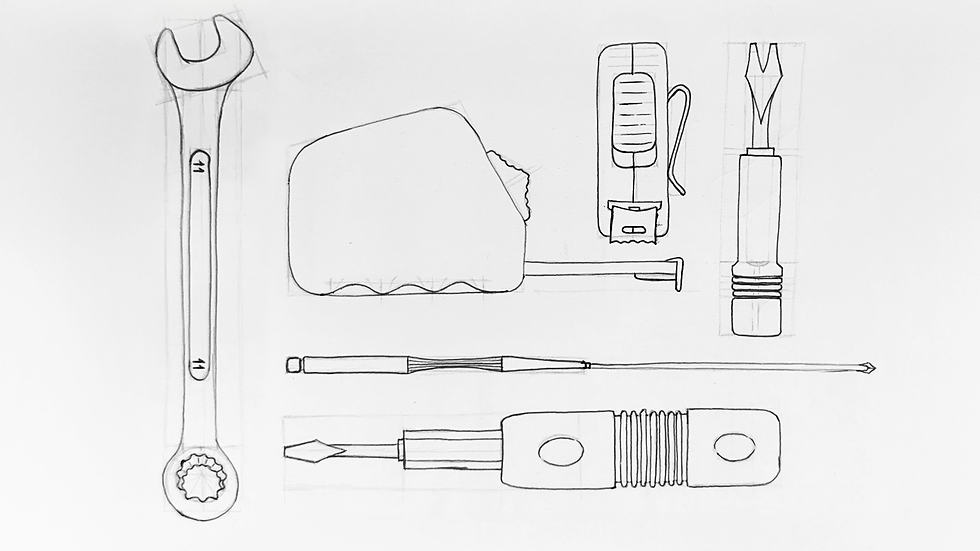Sketches created as a personal study.
Product Design developed during the 7th semester of Visual Design in 2022. With Gustavo Fragão and João Vitor "Kiko" Rossetti Alves. Supervised by Prof. Me. Claudia Weber.
Bringing ideas to life! Through observation, I seek to understand the forms, proportions, and functions of the objects around me. From these insights, I work on developing new product concepts that can improve people's daily lives, offering functional, inclusive, and meaningful solutions.
Sketch and Product Design
ILLUSTRATION | PRODUCT DESIGN
Sketches created as a personal study.
Product Design developed during the 7th semester of Visual Design in 2022. With Gustavo Fragão and João Vitor "Kiko" Rossetti Alves. Supervised by Prof. Me. Claudia Weber.
Bringing ideas to life! Through observation, I seek to understand the forms, proportions, and functions of the objects around me. From these insights, I work on developing new product concepts that can improve people's daily lives, offering functional, inclusive, and meaningful solutions.
Sketch and Product Design
ILLUSTRATION | PRODUCT DESIGN



Sketches of the kirigami developed during the Illustration course in the Visual Design program.
Sketches of the kirigami developed during the Illustration course in the Visual Design program.

During the seventh semester of Visual Design, we developed, in the Universal and Inclusive Design course, a project focused on the daily lives of people with hearing impairments. As a team, we conducted research on the prevalence of this condition in Brazil and worldwide and, with the support of a Libras interpreter, we conducted a virtual interview with a woman who is a homemaker and mother. She shared challenges such as sleeping with the baby monitor on her chest to feel the vibration when the baby cries, placing her phone under the pillow to wake up with the vibration alarm, and identifying when the pressure cooker is ready by sensing the pressure through its handle.
Based on these insights, we discovered See Sound – The world’s first smart home hearing system, an intelligent device that captures sounds at home and sends alerts to a smartphone or smartwatch. Inspired by it, we proposed a mobile device, with different kits, that alerts the user through a luminous signal, adapting to different situations like walking on the street, driving, or working at home. The system could be connected to multiple sound detection units placed throughout the house and, prioritizing low cost and battery efficiency, we designed a LED interface to make the product more affordable and accessible to families from different socioeconomic backgrounds.
During the seventh semester of Visual Design, we developed, in the Universal and Inclusive Design course, a project focused on the daily lives of people with hearing impairments. As a team, we conducted research on the prevalence of this condition in Brazil and worldwide and, with the support of a Libras interpreter, we conducted a virtual interview with a woman who is a homemaker and mother. She shared challenges such as sleeping with the baby monitor on her chest to feel the vibration when the baby cries, placing her phone under the pillow to wake up with the vibration alarm, and identifying when the pressure cooker is ready by sensing the pressure through its handle.
Based on these insights, we discovered See Sound – The world’s first smart home hearing system, an intelligent device that captures sounds at home and sends alerts to a smartphone or smartwatch. Inspired by it, we proposed a mobile device, with different kits, that alerts the user through a luminous signal, adapting to different situations like walking on the street, driving, or working at home. The system could be connected to multiple sound detection units placed throughout the house and, prioritizing low cost and battery efficiency, we designed a LED interface to make the product more affordable and accessible to families from different socioeconomic backgrounds.


The production of this short film coincided with the critical months of the Covid-19 pandemic, demanding more robust computational resources for its complete rendering. We chose to focus on rendering scenes featuring Cynthia, while others were processed through playblast in Autodesk Maya.
During the seventh semester of Visual Design, we developed, in the Universal and Inclusive Design course, a project focused on the daily lives of people with hearing impairments. As a team, we conducted research on the prevalence of this condition in Brazil and worldwide and, with the support of a Libras interpreter, we conducted a virtual interview with a woman who is a homemaker and mother. She shared challenges such as sleeping with the baby monitor on her chest to feel the vibration when the baby cries, placing her phone under the pillow to wake up with the vibration alarm, and identifying when the pressure cooker is ready by sensing the pressure through its handle.
Based on these insights, we discovered See Sound – The world’s first smart home hearing system, an intelligent device that captures sounds at home and sends alerts to a smartphone or smartwatch. Inspired by it, we proposed a mobile device, with different kits, that alerts the user through a luminous signal, adapting to different situations like walking on the street, driving, or working at home. The system could be connected to multiple sound detection units placed throughout the house and, prioritizing low cost and battery efficiency, we designed a LED interface to make the product more affordable and accessible to families from different socioeconomic backgrounds.

